Patagonia Micro Puff Storm Jacket
Reviewer: 5’8”, 155 lbs
Size Tested: Medium
Blister’s Measured Weight: 614.5 grams
Materials:
- Shell: 2-layer H2No w/ 12-denier nylon ripstop face fabric
- Insulation: 65-g PlumaFill
- Lining: 10-denier ripstop nylon
Stated Features:
- Ultralight 2-layer waterproof/breathable H2No® Performance Standard shell fabric
- Revolutionary PlumaFill insulation replicates the structure of down in a continuous synthetic insulation material, offering the warmth, packability and feel of down but with the warm-when-wet performance of synthetic insulation
- Engineered pattern and seamless shoulder design reduce weight and possible abrasion points
- Alpine helmet-compatible hood adjusts with single-pull cord-lock system to work equally well with any type of helmet or a bare head
- Mini elasticized internal snow skirt contours to the body to eliminate drafts
- Self-fabric hook-and-loop cuff closures seal out the elements
Pockets:
- 2 hand (zippered)
- 2 interior (drop-in)
MSRP: $499
Test Location: Crested Butte, CO
Days Tested: 10
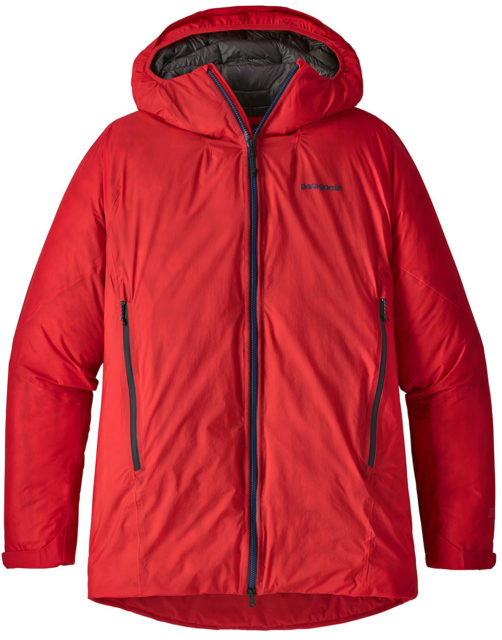
Intro
Last year Patagonia released the Micro Puff Hoody — a synthetic-insulated mid layer that was the first synthetic piece we’ve ever used that truly rivaled down’s warmth-to-weight ratio.
The Micro Puff Hoody and its PlumaFill insulation are extremely impressive, earning the Micro Puff Hoody two of our Best Of awards. But with an ultralight construction and thin, non-waterproof face fabric, it is also pretty limited when it comes to use as an outer layer.
So, this year Patagonia released the Micro Puff Storm. It takes the extremely warm and light PlumaFill insulation of the Micro Puff and combines it with an ultralight, waterproof fabric. I’ve been using the Micro Puff Storm for a bit of touring, a lot of resort skiing at Crested Butte, and casual around-town use during the storms Crested Butte’s been getting lately. And I’ve come away very impressed. Let’s dive in:
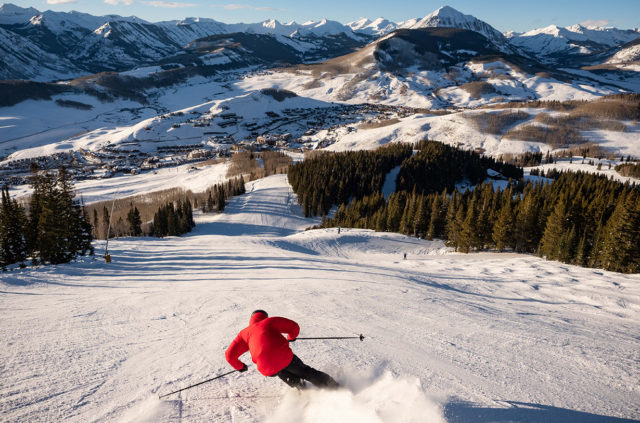
Fit
The Micro Puff Storm shares basically nothing in common with the Micro Puff Hoody when it comes to fit. The Micro Puff Storm is much longer, and has more interior room overall.
Overall, the Micro Puff Storm fits a bit like your typical belay jacket. I can easily toss the Micro Puff Storm over a base layer, mid layer, and shell and still have room to move. The Micro Puff Storm is a bit longer and roomier than the Eddie Bauer BC EverTherm Down Jacket (review coming soon), and about the same length as the Open Wear Open One 3L Jacket (a longer, freeride-fit resort shell).
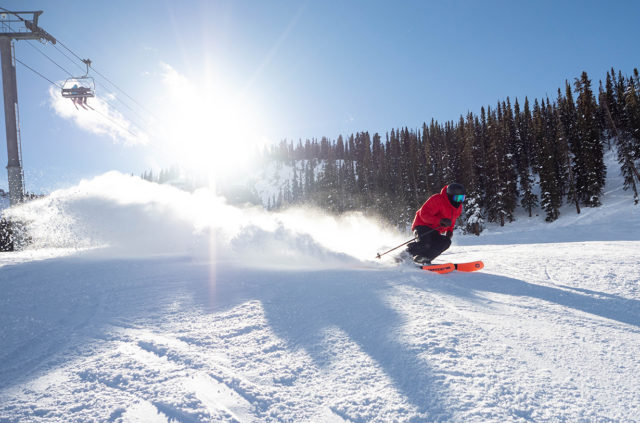
For what I’ve been using it for (skiing and casual use), I love the fit of the Micro Puff Storm. It’ll fit over all my other layers when I’m touring, but is still comfortable when just worn over a base layer.
Features
The Micro Puff Storm is a minimalistic piece, and it’s correspondingly light on features.
It’s got two zippered hand pockets that I can still access with a pack, and two mesh, interior drop-in pockets.
I’m very glad Patagonia went with a mesh backing on the hand pockets, especially since the Micro Puff Storm doesn’t have any pit zips. The hand pockets provide a bit of ventilation when open, but still keep my hands warm since the insulation is between my hands and the elements.
The drop-in pockets are also very useful for storing gloves or other items I want to keep warm.
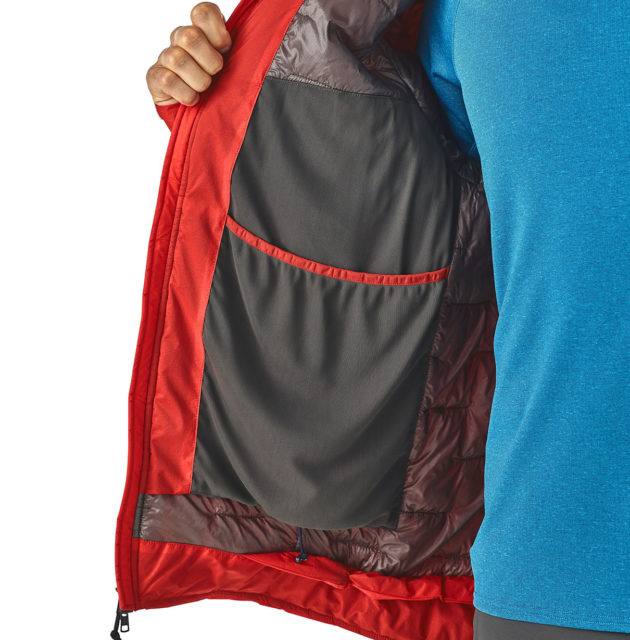
The only thing I’d like to see added to the Micro Puff Storm is a chest pocket. I’d love to have an interior, insulated chest pocket for a phone or small essentials. But the Micro Puff Storm is a lightweight piece and I’ve usually got other small-pocket options on my other layers, so this is a minor complaint.
Besides the pockets, the Micro Puff Storm has an elastic drawcord on the hem and hood, and velcro cuffs. It doesn’t have a true powder skirt, but it’s got a small internal layer of fabric that does a decent job of keeping out snow and drafts. The hem cord locks are routed into the hand pockets, which help keep the jacket clean and prevent the cords from snagging on stuff.
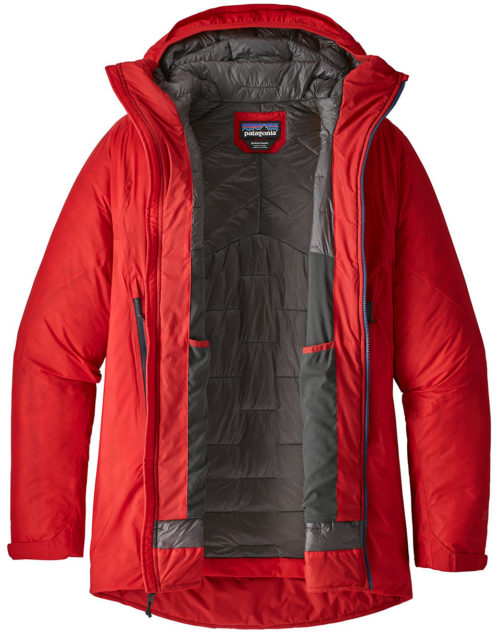
The Micro Puff Storm’s hood is adjustable via one cord lock on the back, and it does a good job of snugging down the hood over a helmet or bare head. The hood also has a small brim that keeps it raised off a helmet, and a bit of elastic around the face to keep it from flapping around. The Micro Puff Storm’s hood isn’t as adjustable and is a bit more restrictive than some 3-point-adjustable hoods like those on fully featured resort shells like the Arc’teryx Sabre LT (review coming soon), but I haven’t had any major issues with the Micro Puff Storm’s hood.
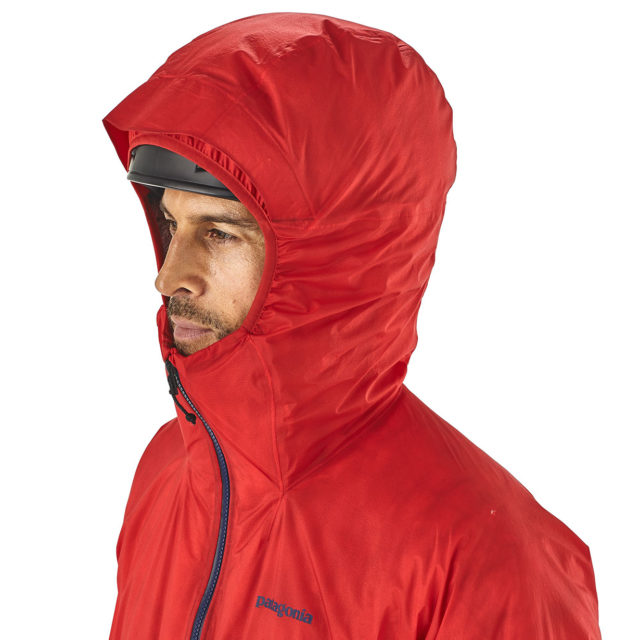
Weight
For what it is — a fully waterproof and insulated jacket — the Micro Puff Storm is very light. The Eddie Bauer BC EverTherm Down Jacket is lighter, but compared to other insulated shells, the Micro Puff Storm is definitely on the lighter end of the spectrum.
When packed down, the Micro Puff Storm compresses to about the size of a volleyball.
For reference, here are a bunch of weights for a number of other insulated, waterproof jackets. Keep in mind the size differences to keep things apples-to-apples.
493 g Eddie Bauer BC EverTherm Down Jacket, size Small (measured weight)
599 g Patagonia Fitz Roy Down Parka, size Large (measured weight)
610 g Arc’teryx Alpha IS Jacket (stated weight)
614 g Patagonia Stretch Nano Storm Jacket, size Large (measured weight)
614.5 g Patagonia Micro Puff Storm Jacket, size Medium (measured weight)
639 g Outdoor Research Floodlight Down Jacket (stated weight)
680 g Arc’teryx Tauri Jacket (stated weight)
825 g Black Diamond Mission Down Ski Parka (stated weight)
850 g Norrona Lofoten Gore-Tex Insulated Jacket (stated weight)
913 g Outdoor Research Blackpowder II Jacket (stated weight)
921 g Patagonia Insulated Snowshot Jacket (stated weight)
936 g Patagonia Primo Down Jacket (stated weight)
1000 g Arc’teryx Macai Jacket (stated weight)
1075 g The North Face Powder Guide Jacket (stated weight)
1125 g The North Face Anonym Jacket (stated weight)
1225 g The North Face Diameter Jacket (stated weight)
1240 g Norrona Roldal Gore-Tex Insulated Jacket (stated weight)
Materials
The Micro Puff Storm uses a very thin and light waterproof H2No outer fabric, 65-g PlumaFill insulation, and a very light Pertex Quantum liner. Overall, I’ve found it to be an extremely comfortable jacket. The outer fabric is a bit crinkly and the lining doesn’t feel great on sweaty skin, but with any layer underneath, the Micro Puff Storm feels like a big, cozy sleeping bag. Except it’s waterproof. And a jacket.
Weather Resistance
After using it in a lot of snow (including some pretty wet storms), the Micro Puff Storm has never let any water through the outer fabric. The DWR works well, and even when the DWR gets overwhelmed and is no longer beading up snow / water, the H2No fabric has prevented water from getting through. I’ve always been happy with the weather resistance of Patagonia’s H2No membrane, and the Micro Puff Storm is no exception.
In terms of wind resistance, the Micro Puff Storm blocks pretty much everything. I haven’t noticed any notable amount of wind getting through the jacket.
Breathability
The Micro Puff Storm has a nylon lining, 65-g synthetic insulation, and fully waterproof outer fabric. So, it came as no surprise that it did not breathe much at all. If you want a waterproof, insulated jacket that breathes a bit better, I’d check out the Patagonia Stretch Nano Storm Jacket.
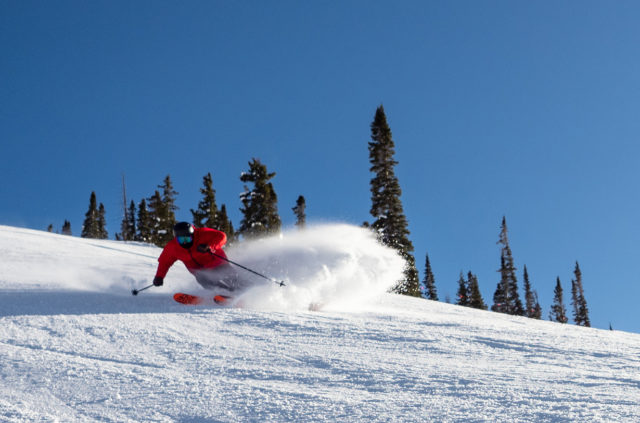
But breathability is not the priority with the Micro Puff Storm. Instead, it’s designed to keep you dry and warm. And it does both of those things quite well. On that note…
Warmth
The Micro Puff Storm is very warm. It’s not as warm as a super puffy jacket like the Patagonia Fitz Roy Down Parka, but it’s noticeably warmer than the standard Micro Puff Hoody. I’ve been perfectly comfortable skiing in the resort with just a base layer and the Micro Puff Storm in temps down to around 10°F.
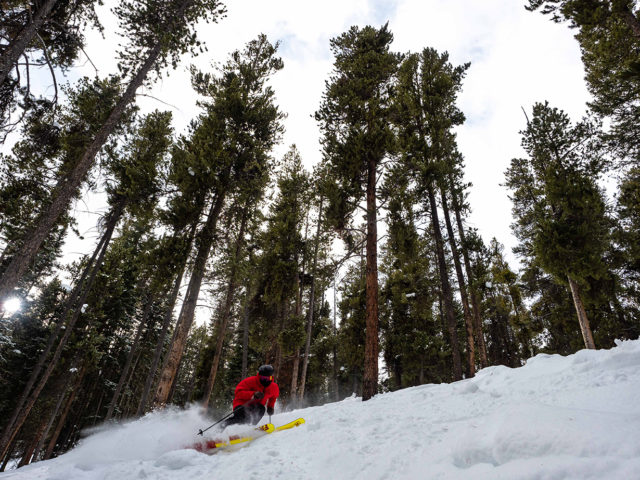
So, the Micro Puff Storm isn’t quite as warm as most belay parkas, but it’s still very toasty.
Durability
I only have around ten days in the Micro Puff Storm right now, and have no durability issues to report. I’ve tried to be careful with it (as I think anyone should be given its lightweight construction), but I’ve still skied through a few trees and bushes without any tears or scratches. As with any lightweight piece of apparel, I’d recommend being extra careful with the Micro Puff Storm, but it’s held up well so far.
I’ll be using the Micro Puff Storm a lot more this season and will report back if any durability issues arise.
Who’s It For?
Anyone who wants a very light, warm, and waterproof jacket.
In particular, I think the Micro Puff Storm should be very appealing to backcountry skiers and snowboarders. While everyone’s layering systems differ, I personally tend to skin up in just a base layer and then throw on a shell and / or insulator when I transition and ski down. With that system, I have to pack both a shell and insulator, which adds weight and time at transitions. The Micro Puff Storm fills both of those roles, is very light, and I don’t have to worry about it getting wet and losing its insulative value. As a result, it’s basically my ideal outer layer for cold-weather touring.
The Micro Puff Storm also works well in the resort and for casual use, but if those are your top priorities, I’d recommend something a bit burlier since the Micro Puff Storm’s fabrics are so thin. In particular, the Patagonia Primo Down Jacket is a great option.
The Micro Puff Storm could also work well as a belay jacket for wet climates. Just keep in mind it’s not quite as warm as puffier parkas like the Patagonia Fitz Roy.
Bottom Line
The Patagonia Micro Puff Storm Jacket is a very impressive piece of apparel. It’s extremely light, fully waterproof, very warm, won’t get cold when wet, and its fit and feature set work very well for skiing, ski touring, and casual use. If you’re looking for a lightweight, insulated, and waterproof jacket, I highly recommend the Micro Puff Storm.

Let’s do apparel Deep Dives!
For use you describe, wouldn’t the Stretch Nano Storm be better? After all, if you were warm enough in cold weather in the Micro-Storm in the resort, it should certainly be enough for the descent part of a ski tour, so if the. Nano-Storm is a bit less warm, that would be fine, and the better breathability would be a big plus, since you will always be sweaty when putting it on at the top of a skin line.
Good question. Right now we just haven’t been in enough jackets in this class (insulated & waterproof) to do a full Deep Dive, but we could definitely do apparel Deep Dives down the line. I’ll be doing an in-depth comparison to the Eddie Bauer BC EverTherm once I get more time in that piece since it’s the closest comparison to the Micro Puff Storm that I’ve used so far.
Unfortunately, I haven’t had a chance to use the Stretch Nano Storm, but from my experience with the FullRange insulation it uses, the PlumaFill insulation in the Micro Puff Storm is significantly warmer. So it just comes down to your priorities. I’d definitely appreciate the breathability of the Nano Storm, but for what I’d be using it for (only during transitions and descents), I’d rather have maximum warmth rather than increased breathability. The Micro Puff Storm also serves as my emergency insulator if I have to be stationary for extended periods of time, so that’s another reason why I’d rather have a warmer jacket than one that’s more breathable. I think the argument could certainly be made that the Nano Storm is the more versatile jacket, but if you’re not using the jacket while you’re working up much of a sweat, I think the Micro Puff Storm serves that purpose better since it’s warmer.
I’ve been using the Stretch Nano Storm as both my puffy and shell jacket for ski touring, and other than relatively minor issues with fit (it’s a bit too baggy), and durability (it’s delicate) have found it ideal. It’s breathable enough to use for breaking trail in cold conditions, and for energetic skiing in mild conditions.
Is . . . . it worth five hundred dollars?
Hey man
Thanks for a great review on this jacket! Would you recommend downsizing for this jacket? I’m usually a large but the fit on this one looks big might go for a M. I’m 185 cm weight around 85 kg.
How does that compare to you? Did you take a L or a M?
Thanks
Hmm, I guess it depends on what fit you’re looking for. I’m 5’8″, 155 lbs and have been wearing the Medium. Since I tend to use it as an outer layer to toss over a bunch of other layers, I really like the Medium. For reference, the Medium comes down to just above mid-thigh on me, and the front zipper measures 81 cm long. So based on that, I think the Medium would probably hit a bit below your waist.